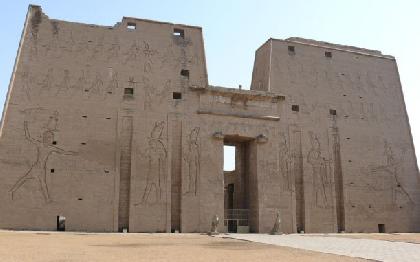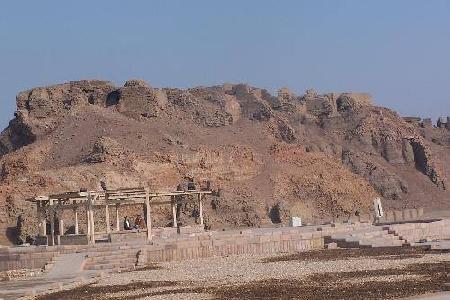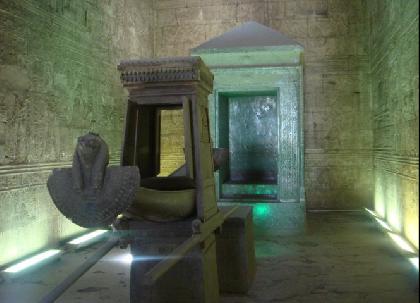Edfu is the capital of a parish in the governorate of Aswan, the last of the Egyptian governorates before reaching the Sudanese borders. The city is located on the West Bank of the Nile River between Esna and Aswan. Edfu, or Behdet in the Ancient Egyptian language, is one of the oldest cities in the whole country. It was known in Greco-Roman times as Apollonopolis Magna, after the chief god Horus-Apollo. It was one of the 40 nomes of the Pharaonic Era, where god Horus, son of Osiris and Isis, was being worshiped. In the Ptolemaic Era, Edfu gained a great importance, because it was on the way to the Red Sea quarries and ports. In Edfu, we can observe how the color and features of people begin to change, as we start entering the historical Nubia, with its African's Camite race people.
Economic activity is based basically on tourism and tourists, who come from Luxor or Aswan in buses or Nile cruises to visit the Great Temple of Horus, Also administration, agriculture and services for the surrounding villages are important resources.
Horus Temple At Edfu
With its perfect conditions, Horus Temple at Edfu is probably the most preserved temple in Egypt. The temple is a fantastic resource for the tourist to have an almost complete idea about how temples were like in Ancient Egypt and how they functioned. The suitable time to visit the temple, which is always crowded with tourists coming from Luxor, Esna, Kom Ombo or Aswan, is after twelve o'clock, then, you will find yourself transported 2000 years in the past and can feel the vibration of the temple, full of life ceremonies, offerings and processions. There are ancient testimonies and remains from the Old and The New Kingdom, but the actual temple was constructed in the Ptolemaic period and its construction and decoration lasted about 1700 years. The temple was dedicated to the god Horus of Behdet (son of Osiris and Isis who conquered god Seth and became the God-King of Egypt in prehistoric times).
The First Pylon of the Temple of Edfu
The First Pylon of the Temple of Horus measures over 34 meters high. It is one of the most preserved pylons of any Egyptian temple where we can find scenes of Ptolemy XIII smiting the enemies of Egypt before Horus. Observing the factions of the enemies, we find that they were not Nubian or Asiatics, like in standard Pharoanic temple scenes, but they were almost Greek and Mediterraneans. The Pylon lost its cornice and in the middle, above the entrance door, we can see the Winged Sun, that commemorates the victory of Horus over Seth. The Pylon also has four niches that once held the ancient ceremonies' flags, And at its front, we can see two granite statues of Horus as a falcon, flanking the entrance to the temple.
The Forecourt of the Temple of Edfu
The forecourt of the temple, or The Court of Offerings, is surrounded from three sides by thirty-two columns. Unlike the Phaaraonic temples, the capitals of the columns have different shape, representing palm leaves, grapes, papyrus, lotus and others. The scenes on the columns represent the king making offerings and worshiping various deities On the walls behind the columns, the reliefs depict different moments of the king's visit and rituals performed in the temple, his being purified and dressed twice as a king of Upper and Lower Egypt, and his being blessed by Horus, the lord of the temple and his wife Hathor. The scenes also show the Feast of the Beautiful Meeting, when Horus and Hathor visited each other's temple. Many of the royal cartouches in the court were left blank because of the unstable political situation in the last third of the Ptolemaic era.
The First Hypostyle Hall of the Temple of Edfu
In the First Hypostyle Hall of the Temple of Edfu, there are 18 columns, 12 of which are free standing and 6 are attached to the walls supporting the ceiling of the hall. These columns represent the Wetlands and the Primeval Water where gods were born and raised. The capitals of the columns, like in the Forecourt of the Temple of Edfu are well elaborated representing different plants. The paints, that once covered every centimeter of the walls and columns, are now lost, but we can still observe very little remains of them, then in the ceiling, astronomical scenes are depicted. On the side walls, we can see the King celebrating the event of the foundation of the temple and dedicating it to Horus (son of Osiris and Isis). On both sides of the hall's main entrance, we can see low small chambers. The chamber on the right side was used to keep the priests' customs. The left one was the temple's library, where papyrus rolls detailing the temple rituals were stored.
The Second Hypostyle Hall of the Temple of Edfu
The Second Hypostyle Hall of the Temple of Edfu has 12 columns supporting the ceiling. These columns are decorated with scenes of the King worshiping different deities. The traditional scenes for the foundation of the temple are depicted on the walls, but, maybe, the most important element in this hall is the play of lights and shadows. The hall is more obscure than the First Hypostyle Hall of the Temple of Edfu and only small holes in the ceiling acted as spotlights. At both sides of the hall, there are small rooms which have stairways leading to the roof. The stairways have scenes representing the priests celebrating the New Year's Festival. However, the roof is now closed. At both sides of the hall, we can see also two chambers that were used to store the offerings and materials necessary for the rituals.
The Vestibules of the Temple of Edfu
The Temple of Edfu has two vestibules before reaching the Sanctuary. Scenes in both vestibules represent the King worshiping Horus and making offerings to him. The outer vestibule has stairs on both sides leading to the roof, which are now closed.
The Sanctuary of the Temple of Edfu
In the Sanctuary, we can see a replica of the original bark of Horus, where his statue was transported in procession to visit his wife Hathor in Dendera. Beside the bark, there is a granite naos which was used to keep the statue. The naos is older than the temple itself as it was ordered by Nectanebo I of the Thirty Dynasty. At the entrance of the sanctuary, we can still see holes that were used to hold the wooden doors that closed the naos. Around the sanctuary, there are ten small chapels that contain texts of hymns to Horus.
The Chambers Around the Sanctuary of the Temple of Edfu
Around the Sanctuary of the Temple of Horus at Edfu, beginning from the right, we can see the Chamber of Offerings, with scenes of the King making offerings to Horus, Hathor as well as Ptolemy III and Queen Berenice. Moving to the left, we can see the Chapel of the Spread Wings where scenes of many deities protecting Osiris are depicted. Next comes a chapel dedicated to Ra with scenes of the coronation of the king and baboons greeting the sun at dawn. This chapel leads to other two smaller chapels dedicated to Khonsu and Hathor. Beside the sanctuary comes the fourth chamber which is known as the Chamber of Horus, then the chamber representing the Tomb of Osiris, then the Chamber of the Throne of Gods and finally the Chapel of Min (the Egyptian god of fertility).
The Outer Walls of the Temple of Edfu
We can reach the outer walls of the Temple of Edfu from the First Vestibule or from the First Hypostyle wall. The scenes on these walls represent the King and Horus smiting Seth and the enemies of Egypt, as well as other scenes of the celebration of their victory. Here, Horus is represented in the final battle against his uncle Seth. Horus standing in a boat, surrounded by allied kings and gods persecute Seth, represented as a crocodile, hippopotamus, or a defeated man with his arms tied.
The Mammisi at the Temple of Edfu
In front of the Temple of Edfu, one can see a small building dedicated to the birth of Harsomtus or Horus, who unites Egypt, son of Horus and Hathor. The capitals of the building have figures of the dwarf god Bes, who used to help in the childbirth. The scenes on the walls, some of which still preserve their original color, represent the Feast of the Beautiful Meeting and some agricultural motifs



